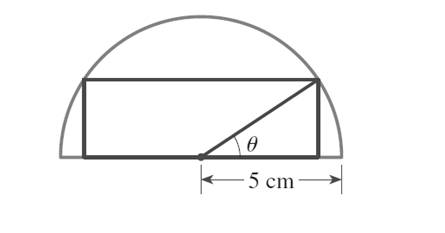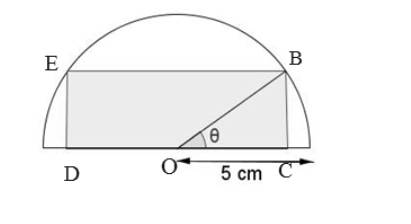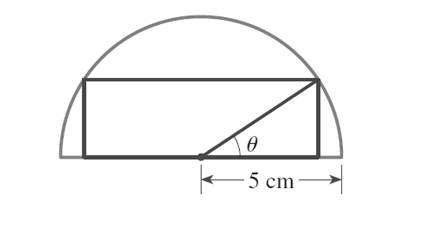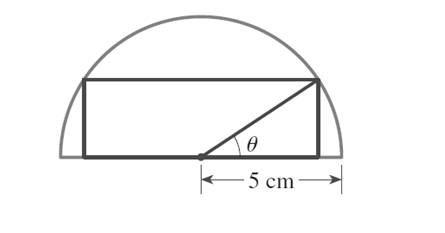
Concept explainers
(a)
To show: that the area of the rectangle is modeled by the function
(a)
Explanation of Solution
Given information:
A rectangle is to be inscribed in a semicircle of radius 5 cm as shown in the following figure.

Calculation:
A rectangle is to be inscribed in a semicircle of radius 5cm, as shown in the figure.

To find the area of the rectangle, need to length
From the triangle
Also,
From the figure,
The area of the rectangle
Substituting
Substituting
Since the area of the rectangle is the function of
(b)
To find: the largest possible area for such an inscribed rectangle.
(b)
Answer to Problem 104E
The largest possible area are
Explanation of Solution
Given information:
A rectangle is to be inscribed in a semicircle of radius 5 cm as shown in the following figure.

Calculation:
The area of the rectangle is modeled by the function
Therefore, the area of the rectangle is the function of the angle
The function
On substituting
So, the largest possible area are
(c)
To find: the dimensions of the inscribed rectangle with the largest possible area.
(c)
Answer to Problem 104E
The length is 7 cm.
Explanation of Solution
Given information:
A rectangle is to be inscribed in a semicircle of radius 5 cm as shown in the following figure.

Calculation:
The largest possible area as
In the first part, shown that
On putting the value of
Know that,
On putting the value of
Thus, the length
So, the length is 7 cm.
Chapter 7 Solutions
Precalculus: Mathematics for Calculus - 6th Edition
 Calculus: Early TranscendentalsCalculusISBN:9781285741550Author:James StewartPublisher:Cengage Learning
Calculus: Early TranscendentalsCalculusISBN:9781285741550Author:James StewartPublisher:Cengage Learning Thomas' Calculus (14th Edition)CalculusISBN:9780134438986Author:Joel R. Hass, Christopher E. Heil, Maurice D. WeirPublisher:PEARSON
Thomas' Calculus (14th Edition)CalculusISBN:9780134438986Author:Joel R. Hass, Christopher E. Heil, Maurice D. WeirPublisher:PEARSON Calculus: Early Transcendentals (3rd Edition)CalculusISBN:9780134763644Author:William L. Briggs, Lyle Cochran, Bernard Gillett, Eric SchulzPublisher:PEARSON
Calculus: Early Transcendentals (3rd Edition)CalculusISBN:9780134763644Author:William L. Briggs, Lyle Cochran, Bernard Gillett, Eric SchulzPublisher:PEARSON Calculus: Early TranscendentalsCalculusISBN:9781319050740Author:Jon Rogawski, Colin Adams, Robert FranzosaPublisher:W. H. Freeman
Calculus: Early TranscendentalsCalculusISBN:9781319050740Author:Jon Rogawski, Colin Adams, Robert FranzosaPublisher:W. H. Freeman
 Calculus: Early Transcendental FunctionsCalculusISBN:9781337552516Author:Ron Larson, Bruce H. EdwardsPublisher:Cengage Learning
Calculus: Early Transcendental FunctionsCalculusISBN:9781337552516Author:Ron Larson, Bruce H. EdwardsPublisher:Cengage Learning





